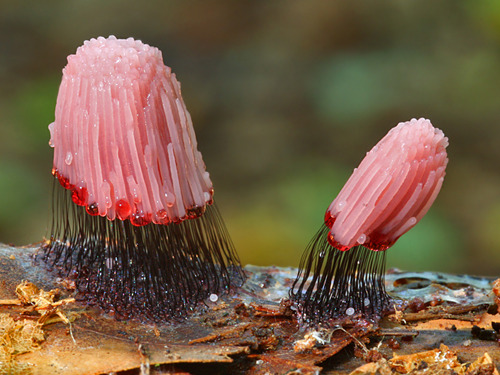While the whole world seek the mysterious life forms in outer space, people failed to realized one of the most intriguing species can be found in our own backyard--slime molds! Yes indeed, these creatures are the linage of amoebas that lived in the soil of Earth for billions of years. Even though their name have the word "mold" in it, they are from the mold that grows in damp areas; they're from a soil amoeba family. While they have been on Earth for quite sometime, they spent their lifetime growing into different forms.
In order to survive, the organism gathered together in groups of thousands to form a single blob. The blob can stretch itself into a form a a slug, allowing it to travel like a worm towards light. When it reach to the surface the cells turn into stiff stalks while others crawl to the top and form a sticky ball of spores. This ball usually get stuck under the foot of animals and travel to different places.
Inside the slug, 1% of the amoebas search for any infectious bacteria. When they find a pathogen, they eat it then detach themselves from the slug, and die from infection to ensure the slug will be in good health. When the slug is ready to make a stalk, more amoebas die to allow others live. They climb onto of one another; transforming their insides into cellulose. 20% of Dictyostelium cells die this way so they the remaining 80% can climb on their corpse and become spores.
Scientists sequence the DNA of these smile mold to figure out how they evolved and found out the two main groups pf smile mold are each other's closest relatives. Dr. Baldulf, a Swedish biologist who is analyzing the DNA of species in the Eumycetozoan Project suggested that these slime molds may be the link to knowing how soil was first developed on land. Traits such as making spores may have first evolved when they came ashore; the ability to form into a slug was later evolved to travel and spread more spores.
I think it's very fascinating something so minuscule can have a connection to the world itself. Comparing to the lifespan of dinosaurs or humans, these slime molds could be as old as the Earth itself. I think it's interesting how the past and the present is connected in ways that people normally overlook. These tiny single-celled organisms work together to ensure the survival of others, I feel we can learn a lot from them, scientifically and about life in general. After all, it's the little things that matter and you'll be surprise what huge surprises they can achieve!
Article: http://www.nytimes.com/2011/10/04/science/04slime.html?pagewanted=all&_r=1&
Related article: http://www.sciencedaily.com/releases/2014/02/140218143318.htm

WOW! This is indeed very intriguing. Never really thought that molds could be linked to the origin of the soil. This discovery could help in answering the many unknown question about the origin the universe. I Hope more research happens in this field.
ReplyDeleteThese little slime molds are pretty cool. I've never seen one before, but I will definitely be on the look out for one. I think it's amazing how some of the amebae will sacrifice themselves, for the well being of the slug as a whole. These slime molds could contain some extremely relevant information to the beginning of the universe. It's surprising how something so important can be so small and go unnoticed for so long. I can't wait to hear exactly what information about the past is hidden in these slime molds.
ReplyDelete